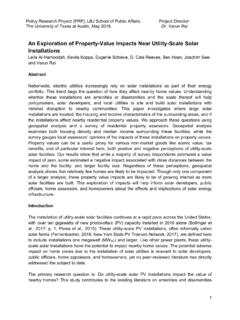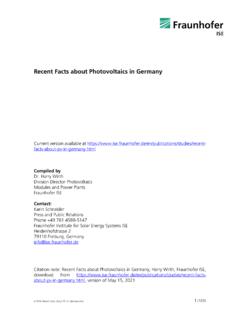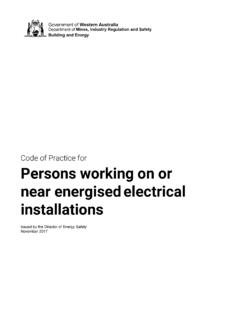Transcription of The Australian Solar Mounting Systems Guide
1 The resource for Australian Solar professionals looking to purchase a Solar Mounting systemThe Australian Solar Mounting Systems GuideSPONSORED BYSponsored byThe Australian Solar Mounting Systems Guide2 IntroductionA Solar Mounting system either rooftop or ground-mounted is an integral feature of any Solar installation, particularly for photovoltaic (PV) by the publishers of EcoGeneration the premier magazine for Australia s clean energy industry The Australian Solar Mounting Systems Guide answers the important questions every Solar system designer and installer needs to ask before buying a Mounting Guide also outlines common mistakes made in relation to Mounting Systems , and how to avoid them while purchasing the highest-quality products best-suited to your on hyperlinked text and imagery to access extra information online, and to find Australian Solar Mounting experts who can help ensure your installations have the strongest start courtesy of byThe Australian Solar Mounting Systems Guide3 What you ll learn from this guideIntroduction 2 Solar Mounting Systems .
2 The key points 4 Mounting system misconceptions busted 9 The importance of industry standards 10 Questions to ask a supplier 12 Mounting system Q&A 13 Common mistakes made when purchasing, and how to avoid them 14 Important considerations: a checklist 15 Sunlock Mounting system product and specifications 16 Featured product: commercial roof brackets for large Australian commercial buildings 17 Need more information? 1924711 Sponsored byThe Australian Solar Mounting Systems Guide4 Solar Mounting Systems : the key pointsThe right Solar Mounting system, if installed correctly, will provide the structural support a Solar system needs, in order to protect it from wind-induced failure and other potential weather hazards. A Mounting system can also set the orientation and elevation of a Solar system, in order to maximise its energy Systems can be designed to sit on a separate sub-frame or tilt legs to provide the ideal inclination for a given made from stainless steel or aluminium, most Mounting Systems are designed for universal application, and can come in a variety of styles including tilt frame, flat roof-mounted or can be customised to meet the size and specifications of a PV installation, as well as the style of roof or good Mounting system should be easy to install, made from quality, rust-free materials or materials with sufficient corrosion protection (such as galvanised steel) and should effectively protect a system s TIP.
3 The Mounting system is the base of the Solar system a good base ensures the efficiency of your overall system, and a return on courtesy of byThe Australian Solar Mounting Systems Guide5 How to check that a Mounting system is safe to useOne of the first things to check with a Mounting system supplier is that the supplier will provide a structural certificate for its product to your customer (these certificates demonstrate that a Mounting system will help prevent damage to a Solar installation and safeguard it in the event of a wind-induced failure) and that the product is accredited to the latest wind code, Australian Standard (AS) At a minimum, installation documents provided by a Mounting system supplier will cover certain limits and parameters, and set out the maximum fixing centres and other specifics for a job; these should be carefully followed to ensure obligations are project and product parameters to check include:LocationThis determines the basic wind speed for the installation.
4 If the site is within 100 km of the coast in Queensland, the Northern Territory or Western Australia, the chances are that it will be in an elevated wind zone. Some Mounting Systems exclude cyclone regions or other wind heightAll Solar panel Mounting Systems will have a limit of building height typically 10 m, but sometimes 20 m. For example, Australian company SunLock supplies a one size fits most set of drawings in its installation manual, but can provide extra certification for any building height, panel size or purlin/batten material or sizeAlways check the maximum panel size the Solar Mounting system is rated zonesSome wind-induced failures can be due to panels installed too close to the edge or ridge of the frame and fixing specificationThe roof frame material, thickness and type of roof screw must be resultsSuppliers of quality framing Systems invest in testing for their products.
5 For example, cyclonic regions are exposed to low-high-low (LHL) cyclic loading, where the modules, frame and fixings are exposed to rapidly oscillating up-and-down forces. Centres such as the Cyclone Testing Station at James Cook University conduct LHL testing, and a range of Australian and international testing centres and firms can certify Mounting byThe Australian Solar Mounting Systems Guide6 How to optimise Solar system tiltCrystalline Solar PV panels produce the most power when they are pointed directly at the sun. In Australia, Solar modules should face north for maximum electricity production. The orientation of the panels will often have a greater effect on annual energy production than the angle they are tilted current feed-in tariff structures in Australia result in east-west-facing Systems generating an optimal return on investment, especially if the property utilising Solar feed-in tariffs has low electricity usage in the middle of the Clean Energy Council s (CEC) Solar guidelines for residential PV recommend a minimum tilt of 10 to ensure self-cleaning by rainfall.
6 And for grid-connected PV Systems , CEC recommends positioning panels at the angle of latitude to maximise the amount of energy produced best return on investment will be generated for the Solar project owner if the system is designed based on the electricity usage pattern of the property on which the project is Australian homes have a roof pitch of 20 30 , according to the CEC s guidelines; if a roof slope is not ideal, a Mounting frame can correct the orientation and elevation of panels. On flat-roof buildings (particularly commercial installations), panel arrays are usually installed on racks at an angle of 15 30 . Some companies typically only install at 15 ; this allows for more modules to be placed on a roof, with less wind loads, lower cost, and the same yield.
7 Yield is surprisingly insensitive to installation site, roof material, roof angle, the size and quantity of Solar panels and the number of module rows used will determine the dimensions, quantity and layout of framing components required for in mind that a lower tilt can allow you to fit more panels on the same roof, and also that tilts generate shadows - make sure there s sufficient space between the rows in a Solar byThe Australian Solar Mounting Systems Guide7 Tips for ground-mounted systemsGround-mounted Systems are often used for medium- to large-scale Solar Systems , are occasionally used in smaller Systems such as off-grid projects, or projects where roof space is not are three types of ground-mounted Systems :Rammed-post (mainly for large-scale projects, as they don t require foundations)Foundation-based (for almost all applications)Post-mounted (used most often for smaller Systems ).
8 All ground-mounted Solar Systems have to comply with AS for ballasted systemsBallasted Systems are mainly deployed on flat concrete roofs. They are suited for this context as they involve no penetration of roof are designed with a small tilt angle (10 or 15 ) with panels in landscape format to limit the wind loading on the blocks hold the system down, and the amount of weight has to be calculated according to AS Allowable extra dead load for the roof has to be checked as Australia, due to high wind loads, these Systems are limited to Wind Region example of a ballasted project is the system installed on the roof of the Federal Parliament House in Canberra, which used the SolarMatrix Pro Mounting courtesy of byThe Australian Solar Mounting Systems Guide8 How wind region effects Mounting system choiceThe Building Code of Australia (BCA)
9 And AS provide guidelines for construction within the different wind regions of Australia:Region A normal wind speedsRegion B intermediate wind speedsRegion C tropical cyclonesRegion D severe tropical BCA states that in all wind areas, a structure must have sufficient strength to transfer wind forces to the ground with an adequate safety margin to prevent:The collapse of the structureThe structure being lifted off its foundationsThe structure being slid off its more about the Australian Standards relevant to wind conditions on page regions of Australia (in accordance with AS )Graphic courtesy of byThe Australian Solar Mounting Systems Guide9 Misconceptions about Mounting Systems bustedAll Mounting Systems are the sameYou only need a few roof screws to hold a Mounting frame to a roofIf a Mounting system has an engineering certificate, then I can use itThere are differences between Mounting Systems , particularly when it comes to quality and service.
10 Individual product providers offer different features and benefits in their Systems . In purchasing a Mounting system product, you generally receive higher quality for a higher need a lot of roof screws for roof-mounted Systems to withstand high winds especially when installing onto thin metal or timber battens. Like buildings, Solar framing needs to be designed for major storm events. The expected lifetime of a building will affect the interval of a weather event some Mounting Systems will be designed for a once-in-100-year event, while others will be designed for once-in-500-year events. Just because it looks strong enough, it doesn t mean that it will check the installation manual for a product, for details about the fasteners it suitability of a Mounting system for your project will depend on the specific details of the engineering certificate, not just the fact that the certificate TIP:The quality of an installation manual for a Mounting system product is a good indicator of the quality of the product.





